Is there anything tastier than a juicy, soft-yet-firm piece of cantaloupe unfurling its delightful flavor on your tongue?
Of course not!
And there’s no better reward for the work involved in planting and growing this tasty melon.
Maybe your melons are looking more and more mature every day, and you’re not sure when to harvest them.
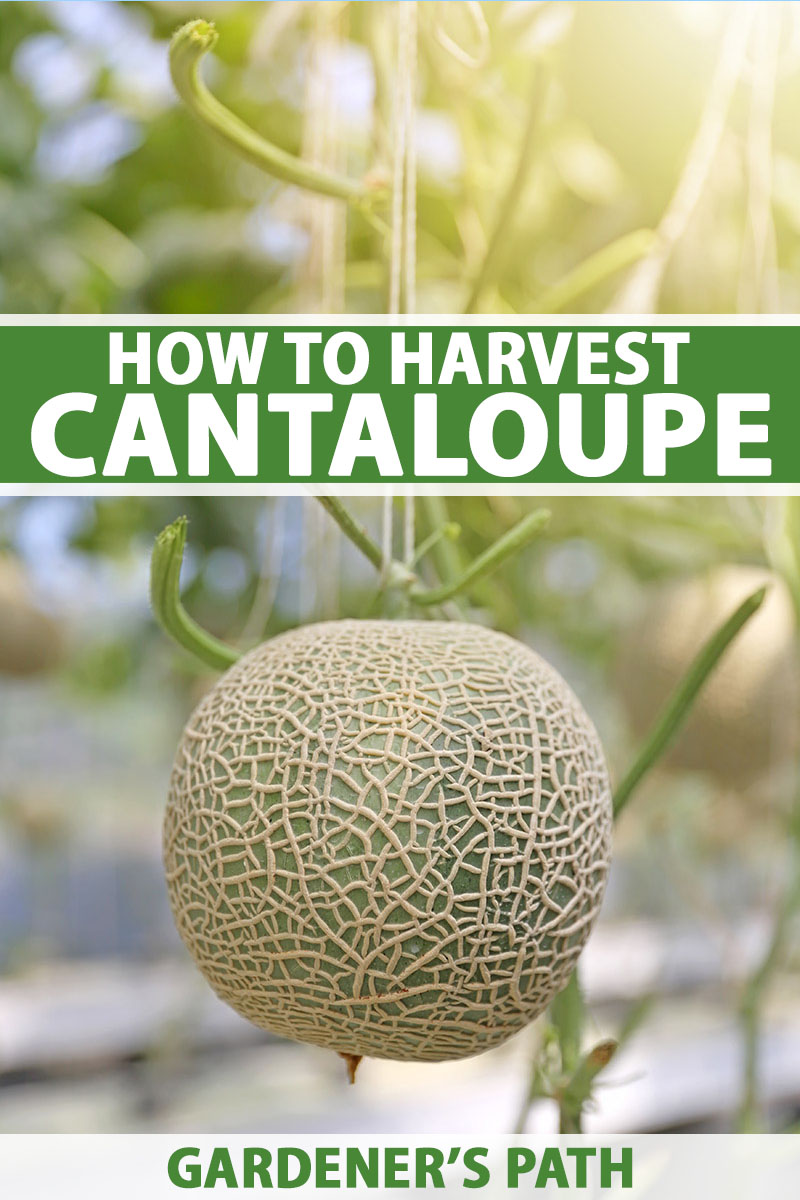
We link to vendors to help you find relevant products. If you buy from one of our links, we may earn a commission.
If that’s the case, you’ve come to the right place, because today we’re going to talk about when and how to harvest this delicious melon (Cucumis melo var. reticulatus).
Here’s what I’ll cover:
What You’ll Learn
When to Harvest Cantaloupe
This sun-loving fruit takes about 65-90 days from germination to reach maturity – depending on the variety – and when you consider the size and complexity of a melon, that’s impressive.
So depending on your USDA Hardiness Zone and the cultivar you are growing, you might be harvesting melons as early as June, while others may have to wait until late August.

You don’t want to harvest your cantaloupes too early or they won’t be sweet enough (this is how I always feel about the seemingly inexplicably named honeydew – sorry, honeydew lovers out there!). And if you wait too long, they’ll get mealy and squishy. Yuck.
If you do harvest a slightly unripe melon, it will continue to soften, but the sugar content of the fruit will not increase. It won’t be quite as sweet as it would be if it had ripened on the vine.
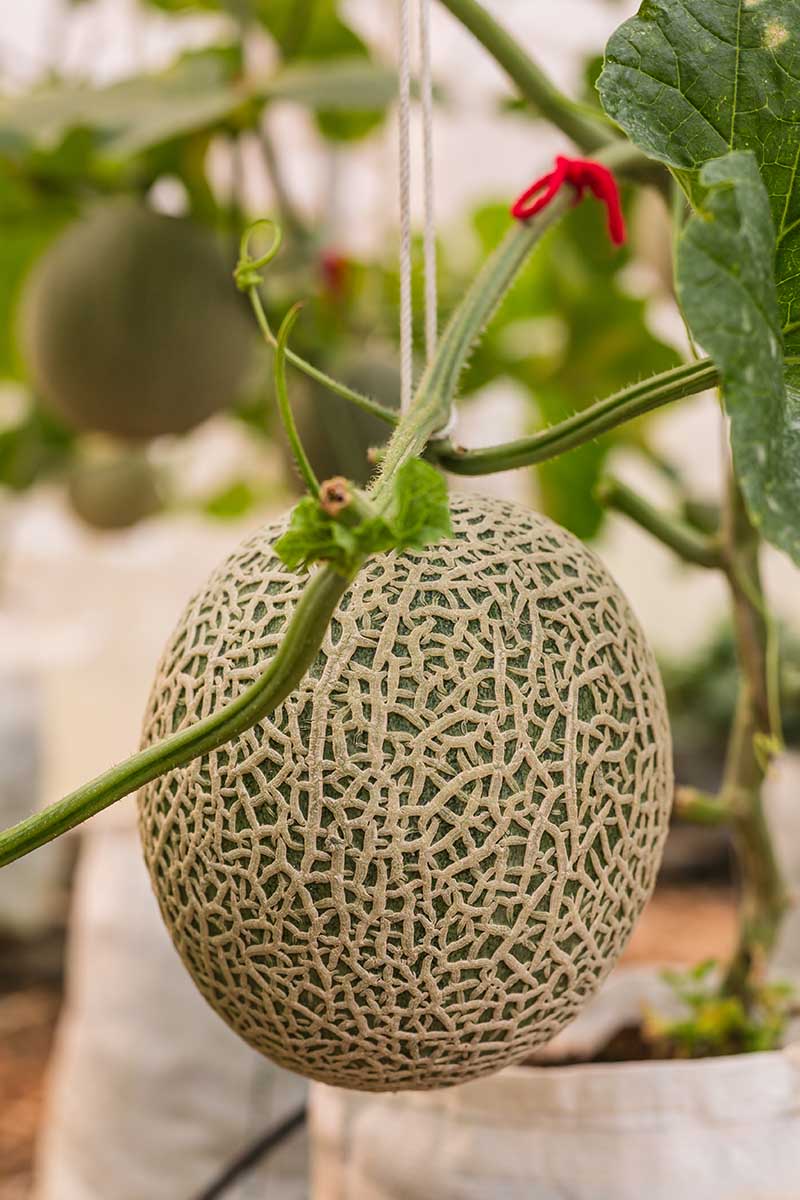
Unripe cantaloupes will still be green, and you’ll be able to see this through the web of “netting” that develops over the rind.
Check your seed packet or your garden planner to determine when they’re about a week away from their due date, and at that point, reduce irrigation. You want to water just enough to prevent the vines from wilting.
This will allow the sugars to concentrate in the flesh of the fruit, and helps to prevent the fruit from splitting.
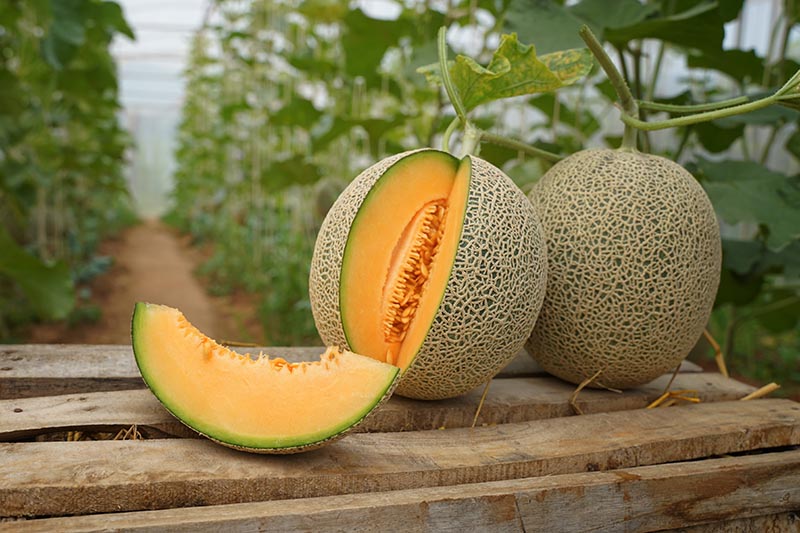
Now is also the time to watch the melons closely. As soon as the netting turns creamy-yellow and the rind below it turns gold, it’s time to sniff the end of the fruit that’s connected to the vine.
If it smells musky and sweet, it’s time to pick!
But if you don’t smell anything, give it another day or two.
While you’re down there sniffing, check the connection between the vine and the melon. Does the melon appear to be detaching from the vine, or is there a crack in the stem? If so, it’s ready for picking.
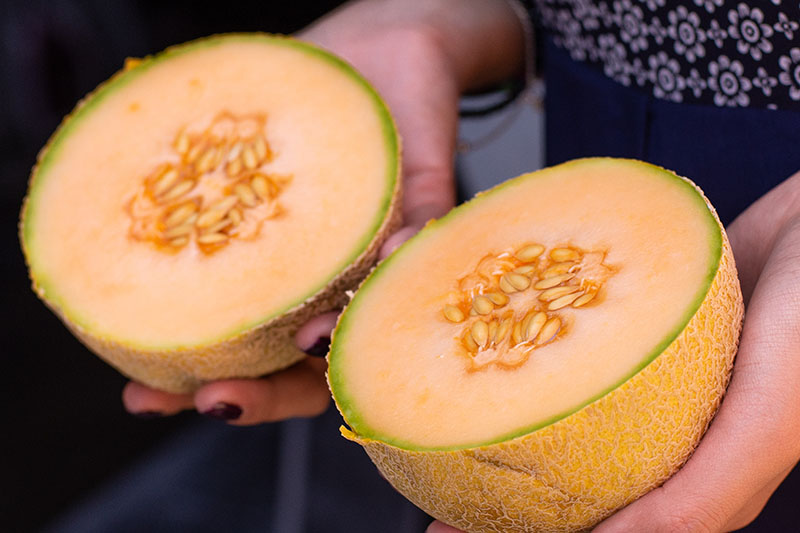
For the best flavor, muskmelons like cantaloupe should be harvested at a stage known as “full slip.”
This is when the stem separates easily from the fruit, without twisting or pulling.
For a longer shelf life, they can be harvested at the “half slip” stage, which is noted when you can see a slight depression at the stem end. But the flavor may be compromised.
This is often done in commercial growing, but there’s no need to compromise flavor when you’re growing your own, if a longer shelf life isn’t a concern for you!
How to Harvest
It’s unbelievably easy to harvest a ripe cantaloupe.
If you live in a colder growing zone and have to work hard to keep the melon warm enough all summer like I do, this is the cantaloupe’s crowning gift – aside from its sweet flesh, of course.
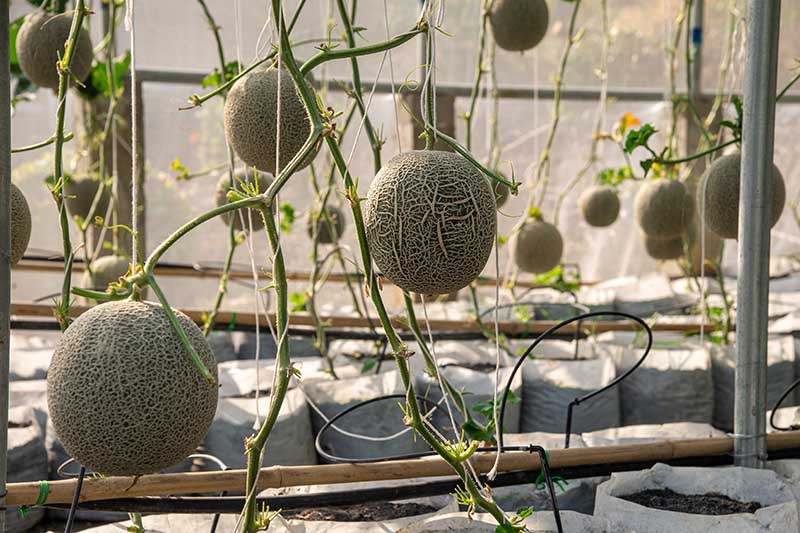
All you have to do is gently pull it off the vine, and it will practically leap into your arms.
That’s literally all there is to it.
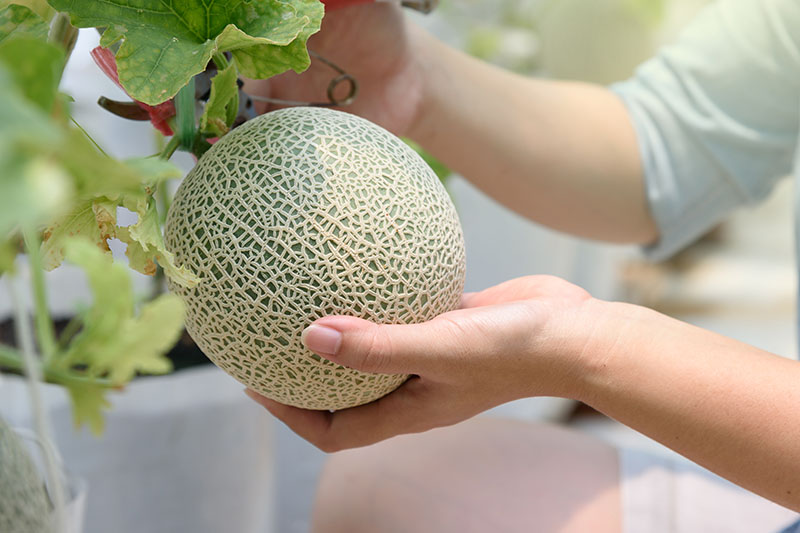
Take it to the kitchen, and if you are going to eat it straight away, scrub the rind with a soapy vegetable brush under running water, rinse it well, and cut it up.
For expert tips on how to do that, check out this cantaloupe-cutting guide from our sister site, Foodal.
And don’t feel ashamed for not knowing how to cut up a bulky melon!
Back when I was in college, I bought an onion for a dish I was cooking in my illicit dorm-room kitchen. (Okay, I had a mini Crock-Pot, which I used often to avoid the greasy cafeteria food). I got a knife out, looked at the onion, and balked.
Even though I’d grown up helping my parents cook, I’d somehow never peeled and cut an onion myself.
Go ahead, laugh at me. But those of you who are hesitant about slicing into your beautiful garden-grown melons can rest assured that you’re not alone.
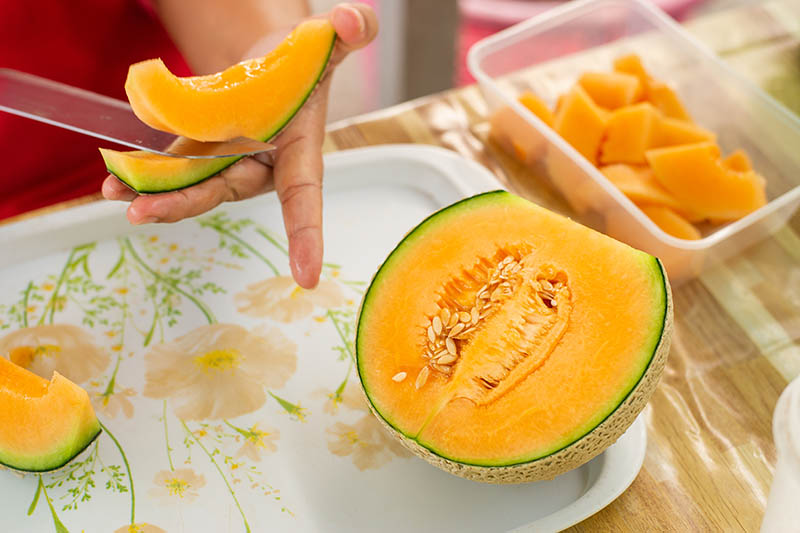
If you’re not going to eat the cantaloupe right away, store it whole and unwashed in the refrigerator. It’ll keep there for a whole week.
Just remember to wash it before you cut it, to avoid letting any bacteria on the rind transfer to the sweet flesh inside.
Cantaloupe that’s already been cut will stay fresh in an airtight container in the refrigerator for up to three days. Or, you can freeze the cubes on a cookie sheet layered with wax paper.
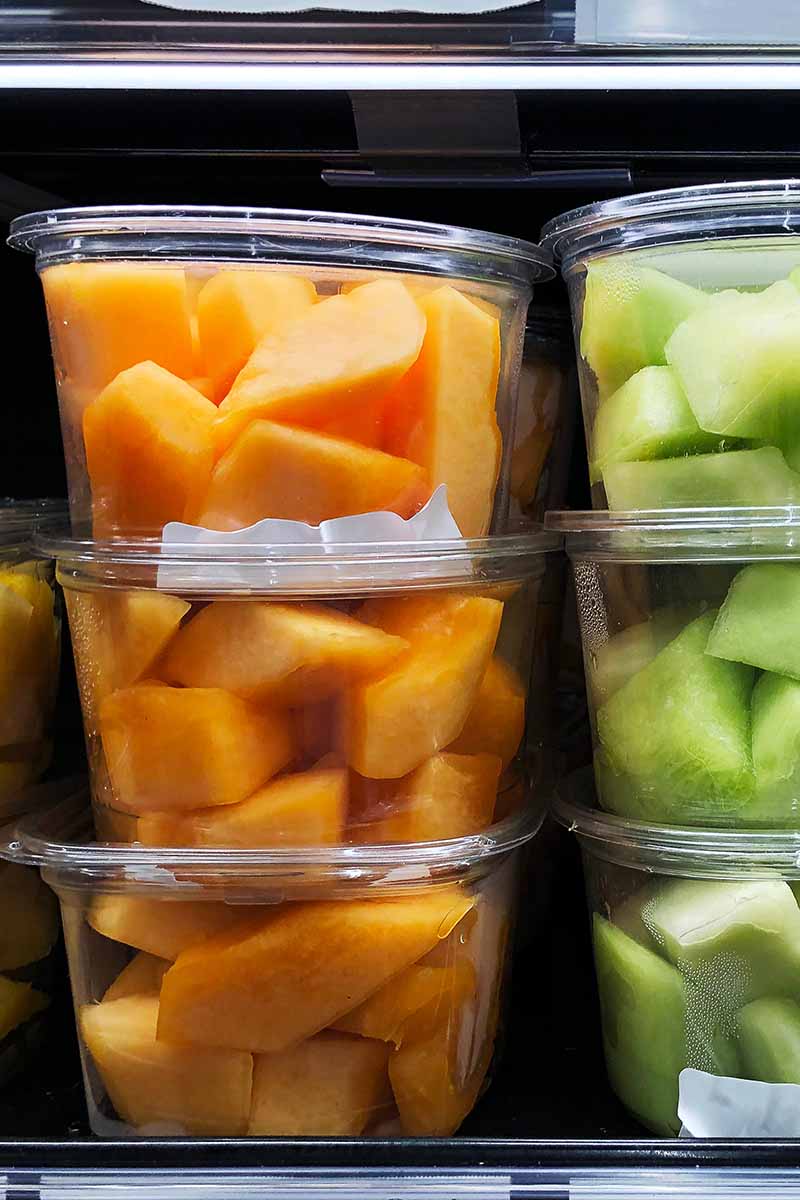
After several hours, transfer them to airtight plastic containers and store in the freezer for up to a month.
Recipes and Cooking Ideas
Most of us probably love eating cantaloupe all by itself, fresh off the rind. And there’s nothing wrong with that!
But it also makes a perfect substitute for mango in this recipe for a strawberry mango smoothie, from our sister site, Foodal (does that not sound absolutely refreshing and amazing?).

For something really different, you can even make cantaloupe bread by substituting freshly grated melon for the zucchini that’s called for in this garden-fresh bread recipe, also from Foodal.
I will most definitely be making cantaloupe bread when these little guys mature at the end of the summer:

Or what about a no-churn cantaloupe, lime, and cream cheese sherbet?
Switch out the mango pieces called for in this frozen dessert recipe for your frozen chunks of melon and prepare for an irresistible taste sensation. It’s perfect for cooling you down on a hot summer’s day. You can find the recipe over at Foodal.
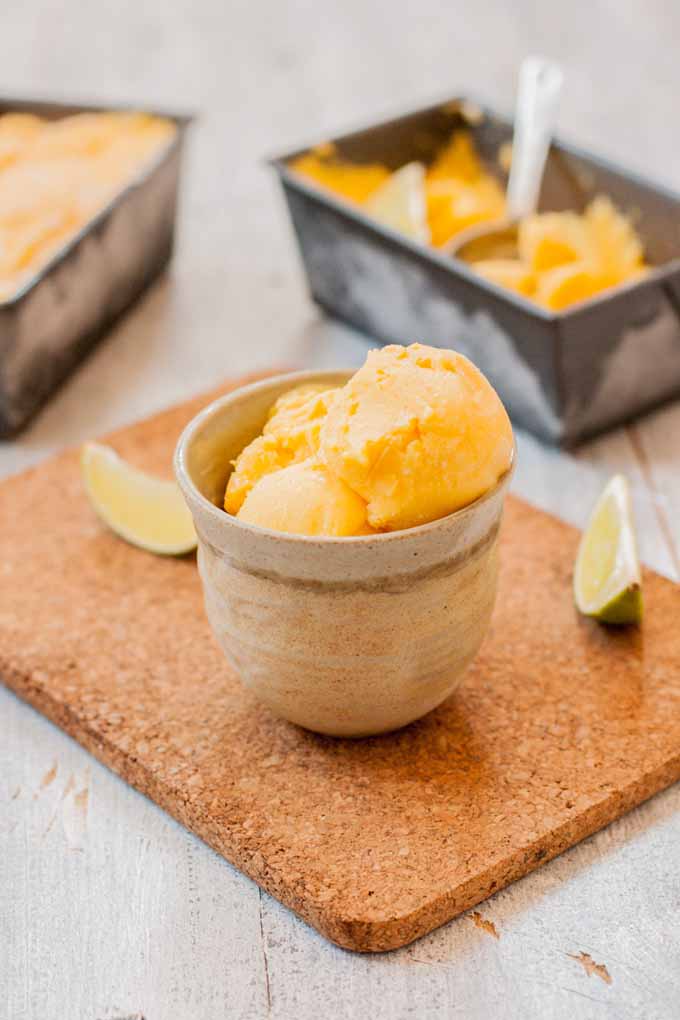
If you want to get adventurous with a sweet and tangy salsa but don’t care for mangoes (guilty!), chop some cantaloupe up into small pieces and toss it into your favorite fruit salsa as a tasty substitute.
With a pinch of creative thinking, there’s so much you can do with this juicy and delicious fruit.
A Happily Harvested Melon
Now that you know how easy it is to harvest your cantaloupes, you can sit back, relax, and watch them mature.

I recommend heading to the garden to check on them daily as they approach their maturation date. Now that you know how to spot the signs of harvest readiness, you’ll know exactly when to pluck them from the vine.
Have you ever grown, harvested, and enjoyed fresh cantaloupe from your garden? Let us know in the comments below!
Are you looking for more cantaloupe growing and care tips? Then check out some of our other expert guides:
- How to Grow Cantaloupe in the Garden
- Train Those Melons on a Trellis: How to Grow Cantaloupe Vertically
- How to Grow Cantaloupe in Containers
Photos by Laura Melchor and Raquel Smith © Ask the Experts, LLC. ALL RIGHTS RESERVED. See our TOS for more details. Uncredited photos: Shutterstock.
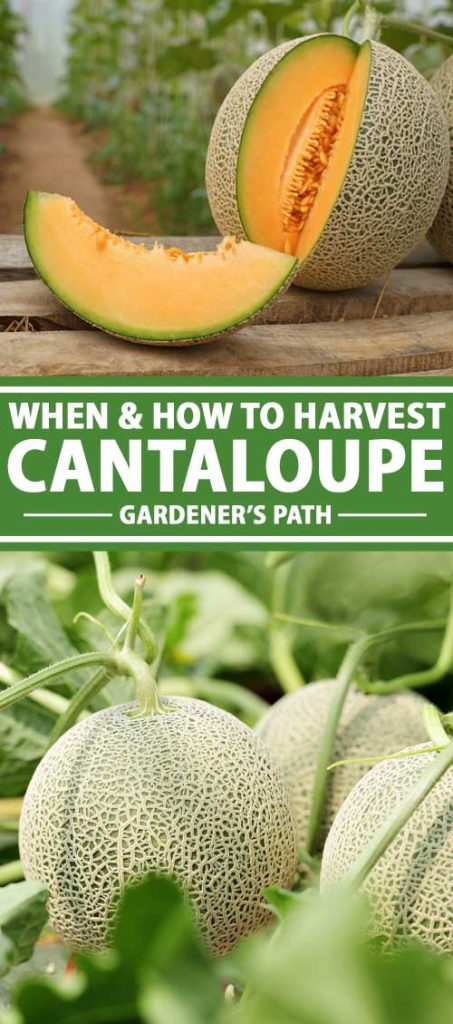
Hi Laura! Amazing how cantaloupes respond to different hardiness zones. And great tip on reducing irrigation just before harvesting. I haven’t done that and have noticed that the skins split sometimes. That cantaloupe bread sounds amazing! Never thought of that.
Hi Chris! Thank you for reading. Totally with you on the hardiness thing — I’m eager to see how my cantaloupes do this year. Still not setting them out in the garden as it’s barely above 60 most days here in Alaska. And yes, cantaloupe bread — let us know if you try it! 🙂
Hi Sarah! You should actually be able to nourish it along for another couple of weeks. Even though grocery store melons don’t always produce fruit, it looks like yours at least did that. So there’s hope!
It looks like Maryland has weather in the 70s this week, which is better than what I have here in Alaska (50s!). Try adding some seaweed powder to give it a kick of potassium. I love this one from Arbico Organics. Make sure it’s getting enough water, too!
Hi Laura,
Thank you for the information.
I have a cantaloupe and a musk melon in my garden. But along with that a melon that starts in the ovoid- football shape green melon with stripes in yellow. As the melon got bigger it became more yellow with less green stripes.
I do not know what kind of melon is this and how to know when it is ready to harvest and how to use it.
Your help with this will be appreciated.
Thank you.
That’s very interesting! Is this melon growing on the cantaloupe or musk melon vines, or did it pop up randomly somewhere else?
Will rain damage my cantaloupe?
Hi Theresa! How much rain are we talking? If it rains a couple times a week, and the melon has a chance to dry off between showers, it should be fine, especially if you’re keeping it up off the ground. If it’s on the ground, though, it could develop a fungal issue from touching the wet earth for prolonged periods of time. I hope this helps!
I have about 10 melons at various stages of development, most with the webbing but still green. Heavy rain is expected in the next few days. Is this likely to damage them?
So sorry for our delayed reply, Heidi! Heavy rainfall or excess irrigation can lead to cracking as melons approach harvest time.
I used cantaloupe seeds from a local grocery store, didn’t have a clue if they would grow or not. Started them in a pot and they sprang up! Transferred them to a larger spot where they really took off flowering. The bees did their job and then I started noticing little cantaloupe on the vines. Now I need to be patient and not pick them until theyre ripe! Should I save some of these seeds for next year?
That’s excellent, Lee! Saving seeds might be worth a shot. Pick your favorite, healthiest-looking melon or two to ripen fully on the vine, and then give it another 2-3 weeks after harvest in a cool spot to ensure that the seeds are fully mature before separating them from the flesh. Some seed-savers ferment theirs, like you might do with tomato seed. Ensure that they are fully dry before storage, to prevent rot. And keep in mind that there’s a chance of cross-pollination if other melons visited by pollinators are growing nearby, so the next generation may not exhibit the same… Read more »
It is the best thing I grow all summer! Thanks for all your tips!
I planted two types of melons mid-May in Maryland. I have three melons in total. I have been searching for information which would let me know when to harvest them. Your advise seems very helpful, I will be looking at them tonight to observe if they are emitting a pleasant smell or displaying an indent near the stem. They look a bit smaller than what I have seen in the stores but other than that they are beautiful. The heat has been brutal this year. Perhaps they are just dehydrated.
Hi:
I am growing cantaloupe for the first time and was wondering how big the fruit should get. They are about 1/3 the size of store-bought melons, but the one I tried today had a sort of golden color, was very soft, super-sweet. That made me think that I may have picked it too late! Is there a reason why cantaloupe would not grow to the store-bought size? Thank you very much.
Plants that are stressed for water, overtaxed with too many fruit per vine, or growing in temperatures cooler than what they prefer may produce smaller fruit than expected. But the variety has a lot to do with it as well, and there are many different varieties of cantaloupe. Do you know which specific type you’re growing? Mature size may vary.